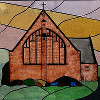A reflection for Sunday 25th February by the Rev'd David Warnes
Think for a moment about something that you once said about which you now feel embarrassed or ashamed. Don’t be alarmed, I’m not going to ask any of you to share it with us. That moment of recollection will give you some insight into how St Peter must have felt when Jesus rebuked him. It’s a moment that he would never forget, though reflecting on it in the light of Easter he knew that he had been forgiven for this and also for later denying that he knew Jesus.
We can be confident that today’s Gospel is an accurate record...
